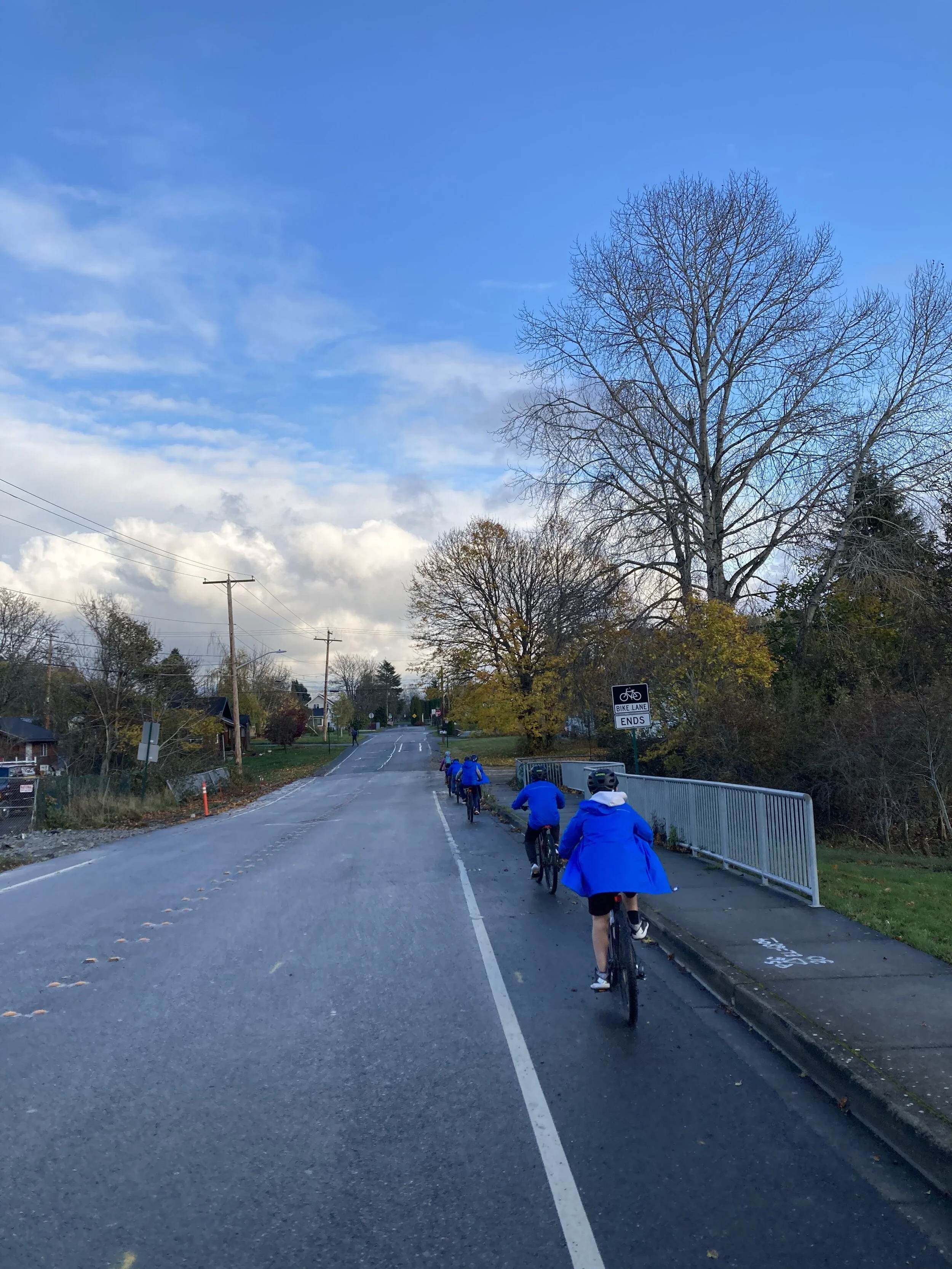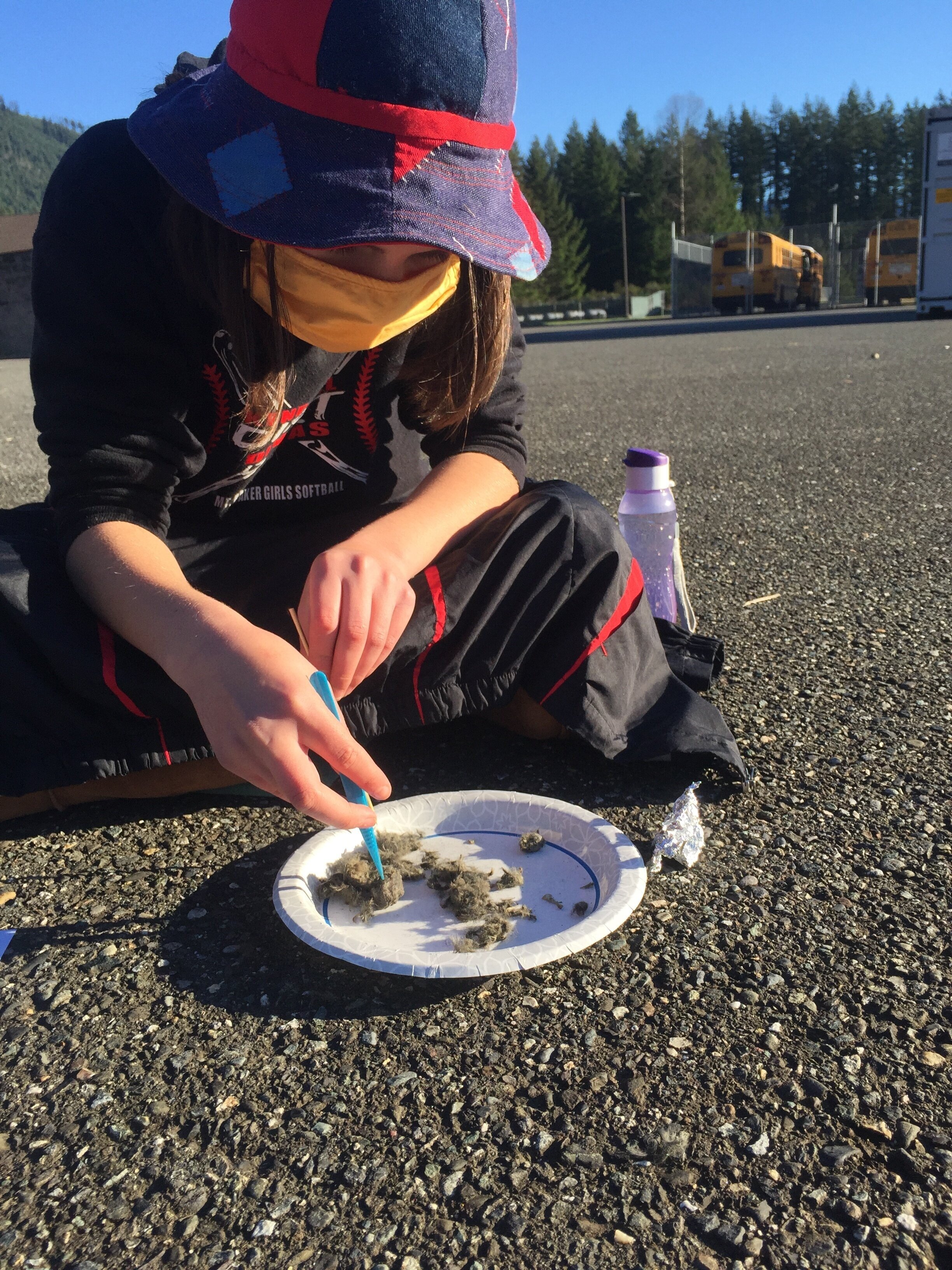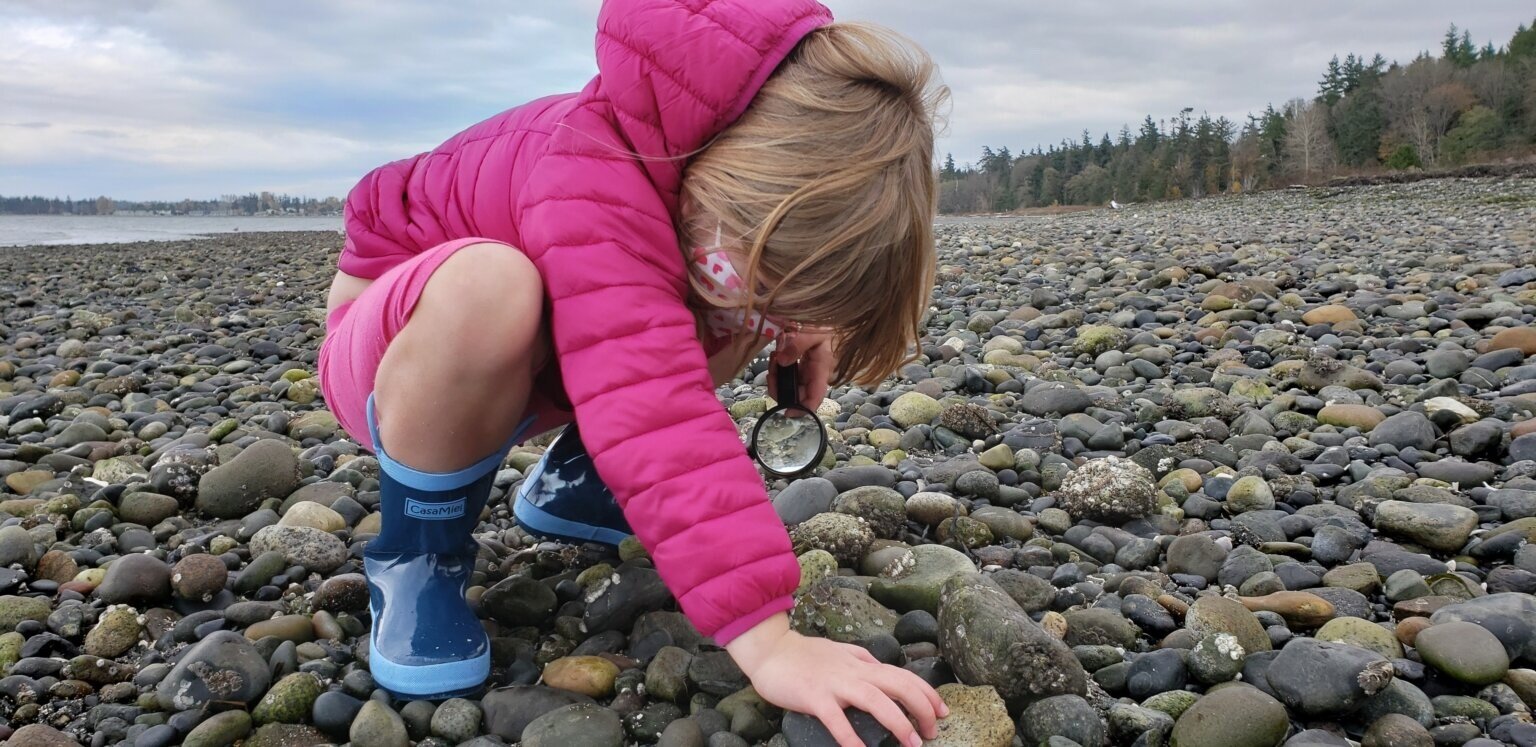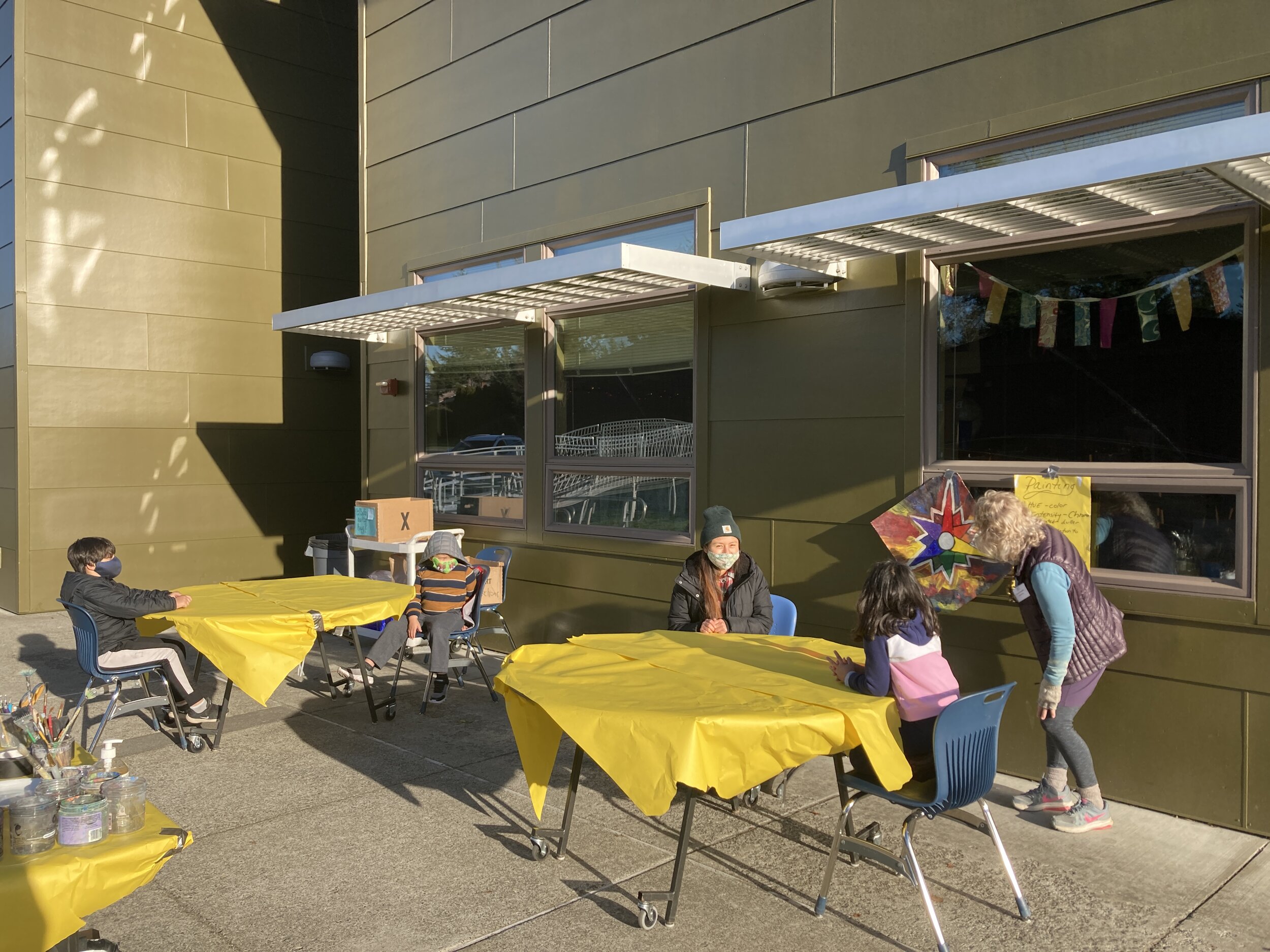Whatcom County, Washington
A Collaborative, Countywide approach to supporting outdoor learning
Whatcom County is a large, mostly rural county in the far Northwest corner of Washington State. Within the county there are seven school districts and dozens of outdoor and environmental education organizations. When the COVID-19 pandemic hit, a group of community-based organizations within the Whatcom Coalition for Environmental Education (WCEE) worked together to partner with districts and support youth. With support from the Whatcom Community Foundation and other funders, the Connections program was created to reach children who could benefit most from access to outdoor enrichment and support for online learning as restrictions were placed on schools during the pandemic.
This case study doesn’t focus on green schoolyards as much as it shines a light on the importance of nonformal educators within a given community and the power of collaboration. Before the pandemic, WCEE outdoor or environmental educators worked outdoors every day. During the pandemic, through the Connections program, participating students were able to be with these experienced educators, receive healthy meals and social-emotional support, and spend time outdoors with their peers.
“Our goal was that, by providing child care, meals, academic support, meaningful interaction with peers and trusted adults, and outdoor enrichment in lower-risk outdoor settings, we could help mitigate barriers to remote learning access for students who could most benefit from this support. In a community like ours, where being active and outdoors is a strongly-held community value, the Connections program helped us provide equitable access for our students. ”
A Collaborative Effort with a
Focus on Equity Springs into Action
INTERVIEWS
We interviewed four people who worked closely to make this collaborative model work:
Keren Bitan and Ben Greené, cofounders of Tandem Impact
Jeff Giesen, North Cascades Institute
Licia Sahagun, Wild Whatcom
Interviews were conducted by Kyle Macdonald, Senior Manager, Green Schoolyards America in December 2020 and January 2021.
Keren Bitan and Ben Greené
Keren and Ben worked with community organizations to start Whatcom Coalition for Environmental Education in August 2019 as a program of the Whatcom Community Foundation, and they currently lead WCEE.
Q: Let's start with a brief explanation of Whatcom Coalition for Environmental Education. What was it set up to do?
Ben: Whatcom Coalition for Environmental Education is a supportive network of collaborators, including nonprofits, agencies, tribal institutions, and businesses, committed to expanding and deepening access to high-quality culturally-responsive environmental education for every child across Whatcom County.
Every two months WCEE has a community of practice meeting, which is really the foundation of the coalition. These meetings can include professional development, peer-to-peer sharing, and working on collective impact initiatives. The community of practice meetings have been instrumental in building collective capacity. The organizations in the coalition collaborate, identify gaps in the environmental and sustainability education field locally, and build on each other's strengths.
Before the pandemic hit, WCEE facilitated a School Partnerships Convening with representatives from Whatcom County school districts, the Lummi Nation School, WCEE organizations, and other community stakeholders. This convening happened in February. The participants focused on writing a collaborative vision for Whatcom County and on deepening and expanding awareness of district assets and needs and program capacities. The convening ended up supporting the work that then happened during the pandemic with the Connections program.
It’s amazing to see what can happen when so many innovative and driven individuals in a community come together to work toward common goals. There are certain problems that can't be solved unless you really take a network approach and involve many different stakeholders. When we think about increasing equity in environmental education, from both a systemic point of view and developing culturally responsive programming, it’s important to take a network approach. The foundational experience of coming together during the School Partnerships Convening, creating a shared vision and developing and deepening relationships between school districts and community-based organizations, has had a lot of ripple effects.
“There was a lot of openness across sectors, from the organizations and partners in the school districts, to say, ‘Let’s see what we might be able to do together. This can happen!’”
Whatcom County, Washington
Location
Shares a border with Canada to the north; the North Cascade Mountains to the east, and the Puget Sound to the west.
Outside of Bellingham, the county seat, the land is largely rural and forested.
Climate
Variable from the coast to the mountains.
Annual snowfall averages fewer than 10 inches in the western portions (Bellingham) to as much as 400 inches in the mountains (Mount Baker).
Annual average summertime high temperatures: ~70°F to 75°F.
Annual average wintertime low temperatures: ~32°F to 37°F.
“There are certain problems that can’t be solved unless you really take a network approach, and involve many different stakeholders.”
Q: What happened in WCEE after the School Partnerships Convening, when the pandemic began?
Keren: In the spring in Whatcom County, similarly to across the country, learning shifted to all virtual. WCEE organizations were trying to figure out how they could best serve students, and that became a central topic of the community of practice meetings. In the summer, Vamos Outdoors spearheaded an innovative collaborative program, with help from Wild Whatcom and Whatcom Mountain Bike Coalition, with the Bellingham Public Schools to support students during the pandemic. That work really served as a model for what was possible.
WCEE brainstormed what the organizations might be able to offer, and we met with district leaders to learn how we might be able to best partner and support youth. Together we imagined various possibilities that were different from previous partnership models. The organizations were willing and able to adapt to meet emerging needs of students and to utilize their expertise working with kids outside. Districts were willing to consider what we could co-create.
As ideas gained traction, we were sharing what potential programs might look like with funders. It got to a tipping point toward the end of the summer, where it seemed like there were clear opportunities in three different school districts and funders were interested in [being] quickly [supportive of] this unique program [taking] shape. While the program specifics look different in each district, one of the central tenets is the same—utilizing outdoor spaces and enrichment to support kids during a tumultuous time. Kids participating in Connections are able to get outdoors with their friends, peers, trusted adults and have a variety of amazing outdoor experiences, from working in the garden to petting animals. What is really exciting to see is that through this collaboration, kids have the opportunity to have experiences that range from going to a stream and interacting with wildlife, to petting bunnies, nature journaling—even having experiences with artists outdoors. It's been really an inspiring thing to see come together.
Ultimately, the Connections program was on the ground before some schools were bringing kids back in session, so it was able to serve as a model, in some instances, of how, with the right safety protocols and working outdoors, there was a way to see kids in person. The collaborative nature of the program, where multiple different community-based organizations were partnering together and intentionally partnering with the district to reach students who could benefit most, was unique.
Q: What was a key ingredient that made it work?
Keren: There was a lot of openness across sectors, from the organizations and partners in the school districts, to say, “Let’s see what we might be able to do together. This can happen! Let's keep trying to make it happen. Let's keep working together. We're stronger together than apart.” As we were ideating, we were all staring into a void together and we didn't know what the outcome would be—that can be really difficult. But leaders in the organizations, school districts, and WCEE remained optimistic that if we just kept moving forward together, we'd come up with something innovative that could work.
Lead Partners in three different school Districts: One Urban, Two Rural
Licia Sahagun and Jeff Giesen represent the lead agencies within the Connections program collaborative, working in different locations. Jeff and the North Cascades Institute worked with the more rural Mount Baker and Blaine School Districts. Licia and Wild Whatcom worked with Bellingham Public Schools. Bellingham is the largest city in the county, with a population of just under 100,000 people.
Jeff Giesen and Licia Sahagun
Q: You both ended up leading your own organizations and facilitating other organizations in providing services for young people in two regions. How did that happen?
Licia: Initially my role was as an advocate—an advocate for outdoors, as we were learning that there was reduced risk due to COVID-19 in gathering outdoors. We began asking, Why don't we utilize the capacity in the spaces that we have here to keep kids connected? To keep them learning in a safe way. I wrote an article for the Cascadia Weekly here, outlining the studies that demonstrated the reduced risk of gathering outdoors. I thought, we have this great collaborative of outdoor educators. Let's use this capacity to support students and to support the district in the fall. And so for me it felt like I really kind of moved into an advocacy role with the community, with funders, and with the district to say, Let's go outdoors!
Wild Whatcom then took on a leadership role in the Bellingham school district on behalf of our organization and eight other partners to design the program, to coordinate how the partners would collaborate together, what the scheduling and the staffing looked like, what the funding would look like. We were working directly with a district liaison to share our vision, [and then we] moved to co-creating the design of the program—ideally with the best interest in mind for the district, but also we were squarely focused on reaching students who could most benefit from additional support.
Jeff: We were not an early adopter like Licia and Wild Whatcom were. I said, “We have too many things going on in our own organization. We have our own big programs to figure out. We need to focus internally. I always had really nice connections with the school districts, but all of a sudden I was not getting airtime anymore. I quickly realized during the beginning of the pandemic that school districts were not wanting to talk individually to 15 organizations about outdoor ed programs, and the coalition became the voice.
Once we joined, Licia and Wild Whatcom were set with Bellingham, so they asked if we [at the North Cascades Institute] could take on the rest of the county and we said yes! We ended up helping with Blaine and Mount Baker school districts, both far more rural than Bellingham. Their needs were really different.
Licia created the templates [in Bellingham]. But soon after, you got deep into talking to the superintendent or the curriculum person, or they said here's what type of kids we have and here's what we need—[their needs were] different. For example, Licia had [been working with a model of] four days a week with half the time having the kids work online. We went out to Mount Baker and Blaine—they were not really interested in kids working online. They wanted them to get outdoors. They said, “We want them one day a week because we're bringing our kids back sooner.” Programming from the district got started with K through 6 much sooner within these two districts. They just seemed less afraid of COVID—less mask wearing. My biggest challenge was making sure my staff were safe. None of them got COVID, but they all had roommates and we had to quarantine because of roommates that tested positive.
Q: It seems like you two were almost bringing a suite of services from a number of outdoor education nonprofits to your respective districts. Is that right?
Licia: I would say so, yes. We went into the fall thinking we’d mirror these programs as closely as we can to each other so that it would be seen as a county-wide effort to run the Connections program in collaboration with outdoor educators. That was the intention. As we got deeper into implementation, the actual program model and design changed depending on the demographics or the number of kids served, the school schedule, and parameters set by each school district. Jeff and I were both playing a role coordinating partners, developing the program design, serving as liaison with the district to implement. We were also both playing point with funders, to fundraise for the program, and playing point with Ben and Keren as well to help get the word out. We tried to keep in contact to make sure our efforts were as coordinated as they could be.
“This program has provided our students an opportunity to engage in hands on outdoor learning in support of their in class content. We are appreciative of the community partners and collaboration to provide this to our students and feel it models what can happen when people unite and work together.”
“Students are able to participate in hands-on experiential learning opportunities at the neighboring Harrison Reserve. This program was a perfect opportunity to leverage the natural resources of Mount Baker to support student learning.”
Whatcom County school districts and the Connections Program:
by the Numbers
Bellingham
22 public schools
12,000 students and 1,300 staff
33.3% of public school meals were free/reduced in 2019
Number of Connections student participants: 116
Demographics: 2nd through 8th grade; 100% of students served fell into one or more of the following groups: English language learner, from a low-income family, houseless or formerly houseless, had an individualized education plan or similar behavior management plan; recommended by a counselor, English learning language specialist, or admin; more than 12 languages were represented among the students served
Blaine
7 public schools
2,206 students and 122 teachers
49% of public school meals were free/reduced in 2019
Number of Connections student participants: 22
Demographics: K through 2nd grade; students chosen by school employees based on known backgrounds, family situations, whether they received free and reduced lunch (i.e., students furthest from opportunity)
“I quickly realized, during the beginning of the pandemic, that the district was not wanting to talk to 15 organizations about outdoor ed programs, and the coalition became the voice.”
Jeff Geissen briefly explains the Connections Program while outdoors with some of the students involved.
Q: Tell me about the program and how much of the time the students were outdoors.
Licia: In Bellingham we were having breakfast and lunch outdoors. Between breakfast and lunch we were in the classroom in cohorts, supporting students to connect on district-issued devices to their online learning. Then after lunch we were outside with a rotation of outdoor ed partners, who offered a range of activities from mountain biking and garden education to nature exploration and nature art. The fact that about 60 percent of our instruction was outdoors is, I would assume, a huge shift to the way that academic learning was approached within the school district’s buildings.
But a piece I should say that is very critical is that we don't have the most pleasant weather year round in the Pacific Northwest. It can be dangerous to be outside November, December, January, February due to wind, rain, or cold. We, as outdoor educators, have the systems in place and the expertise to know how to do risk management outdoors, to equip students, and to know when to come indoors for safety reasons. One of the things I should note: With our program, we gave every student a rain jacket, hat, and gloves for free. Many of the students also received rain pants. We equipped students to be outside when it was raining horizontally, windy, and cold. We were also well equipped to say to our staff, it's 30-plus-mile-an-hour gusts. Do not go into deciduous forests. Those kinds of outdoor risk-management systems that aren't necessarily in place in the district. So I just say that to point out that we may not be able to immediately expect districts to be able to bring all students outdoors safely all the time.
Jeff: One very big difference for us was this: Licia's group was working with students on their synchronous days [every day except Wednesday] Both Blaine and Mount Baker programming happened the one day a week they weren't in school, their asynchronous day. So, we were with students one day a week, a Wednesday or Friday. The only schoolwork the students were assigned on this day was a half-hour online check-in. In Blaine, the district was not ready for kids to be on their campus, so we rented a nearby church. Because of the little online time needed, all of the students in Blaine and Mount Baker spent the majority of their time in the Connections program outdoors, including most breakfasts and lunches.
“We were also well equipped to say, ‘It’s 30-plus-mile-an-hour gusts. Do not go into deciduous forests.’ It’s those kinds of systems that aren’t necessarily in place in the district. So there’s a whole layer of outdoor risk management that districts are not necessarily well versed in but that we are.”
Connections’ Partner Organizations
Allied Arts of Whatcom County, Animals as Natural Therapy, Bellingham Parks and Recreation Department, Camp Saturna, Common Threads Farm, Garden of the Salish Sea Curriculum, Nooksack Salmon Enhancement Association, North Cascades Institute, RE Sources, Whatcom Conservation District, Whatcom Mountain Biking Coalition, Wild Whatcom, Vamos Outdoors Project
Media Coverage
“Some kids have been learning outdoors for months in Whatcom County, but not in Seattle”
— KNKX Radio, December 18, 2020
“Outdoor Learning during a Pandemic”
— North Cascades Institute Blog Post, December 8, 2020
“Stay Connected: Opening Doors to Outdoor Learning”
— Cascadia Weekly, July 29, 2020
“Opening Doors to Outdoor Learning”
— Wild Whatcom Blog Post, by Licia Sahagun, July 10, 2020
Additional Documents and Resources
Connections Program Proposal
— Whatcom Coalition for Environmental Education
This is the document used as a proposal for prospective funders.
Sample Program Schedule
— Connections Program
This is the schedule used by the Mt. Baker team of outdoor educators.
Partnerships in the Pandemic Spotlight: North Cascades Institute
— The Lawrence Hall of Science at UC Berkeley
Interview done by the BEETLES Program as part of their Partnerships in the Pandemic series on outdoor, in-person learning.
Google Map of Outdoor Spaces as Classrooms
— Whatcom Coalition for Environmental Education, a program of the Whatcom Community Foundation
Map of outdoor spaces on school grounds or within walking distance of schools that can be utilized as classrooms.
National COVID-19 Outdoor Learning Initiative
The National COVID-19 Outdoor Learning Initiative supports schools and districts around the country in their efforts to reopen safely and equitably using outdoor spaces as strategic, cost-effective solutions to increase capacity onsite and provide access to abundant fresh air. The Initiative seeks to equitably improve learning, mental and physical health, and happiness for children and adults using an affordable, time-tested outdoor approach to keeping schools open during a pandemic.




















